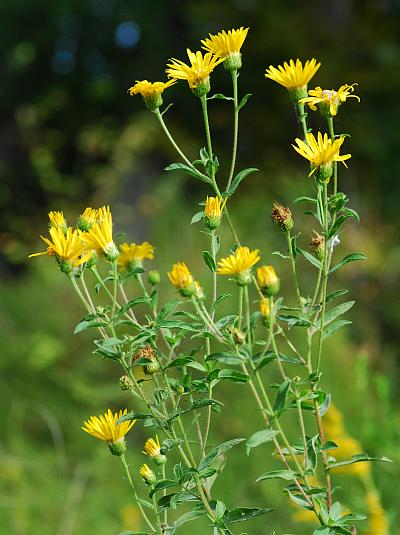Heterotheca camporum var. glandulissima Semple
Golden Aster

Native
CC = 1
CW = 5
MOC = 2
© SRTurner
Heterotheca camporum var. glandulissima SempleGolden Aster | |
 |
Native CC = 1 CW = 5 MOC = 2 |
© SRTurner |
|
Family - Asteraceae/Astereae Stems - To 1.4 m, ascending to erect, usually branched, moderately pubescent with long, spreading hairs with pustular bases, and also moderately to densely minute-glandular.
Leaves - Alternate, with lower leaves usually wilted at flowering. Stem leaves reduced upward, sessile. Blades simple, essentially entire, to 7 cm, narrowly oblong-lanceolate or oblanceolate, sometimes clasping the stem, often somewhat curved and contorted, surface and margins hairy and roughened, often glandular.
Inflorescences - Mostly solitary heads at branch tips. Involucres - Involucres 7-10 mm long, the bracts in 3-6 unequal, overlapping series, narrowly lanceolate to nearly linear, sometimes purplish-tinged at the tip, the green central stripe usually easily observed, hairy and glandular.
Heads - Receptacle flat or slightly convex. Ray florets 15-35, pistillate, the corollas 11-15 mm long. Disc florets 25-65, perfect, the corollas 5.0-6.5 mm long, glabrous or nearly so. Pappus of the ray and disc florets similar, consisting of an outer series of several minute scales 0.2-1.0 mm long and an inner series of 25-45 bristles 5-7 mm long, these usually brown at fruiting.
Fruits - Fruits of the ray and disc florets similar, 1.5-4.0 mm long, somewhat flattened, 3- or 4-nerved on each face, hairy.
Flowering - July - October. Habitat - Roadsides. Origin - Native to the U.S. Other info. - This is a relatively rare variety of Heterotheca camporum characterized by longer, less hairy and more densely glandular stems than the far more common var. camporum. The glands are quite small but can be seen in the stem photograph above as tiny shining dots. The taxon was first recognized as distinct by Semple, who documented a sudden radiation of this form in the southeastern U.S. beginning about 1925. In addition to its morphological differences, the variety is more highly disturbance adapted and can form large populations along roadsides. So far, however, it has only been documented from two counties in Missouri. Photographs taken near Johnson's Shut-Ins State Park, Reynolds County, MO, 10-1-2018 (SRTurner). |